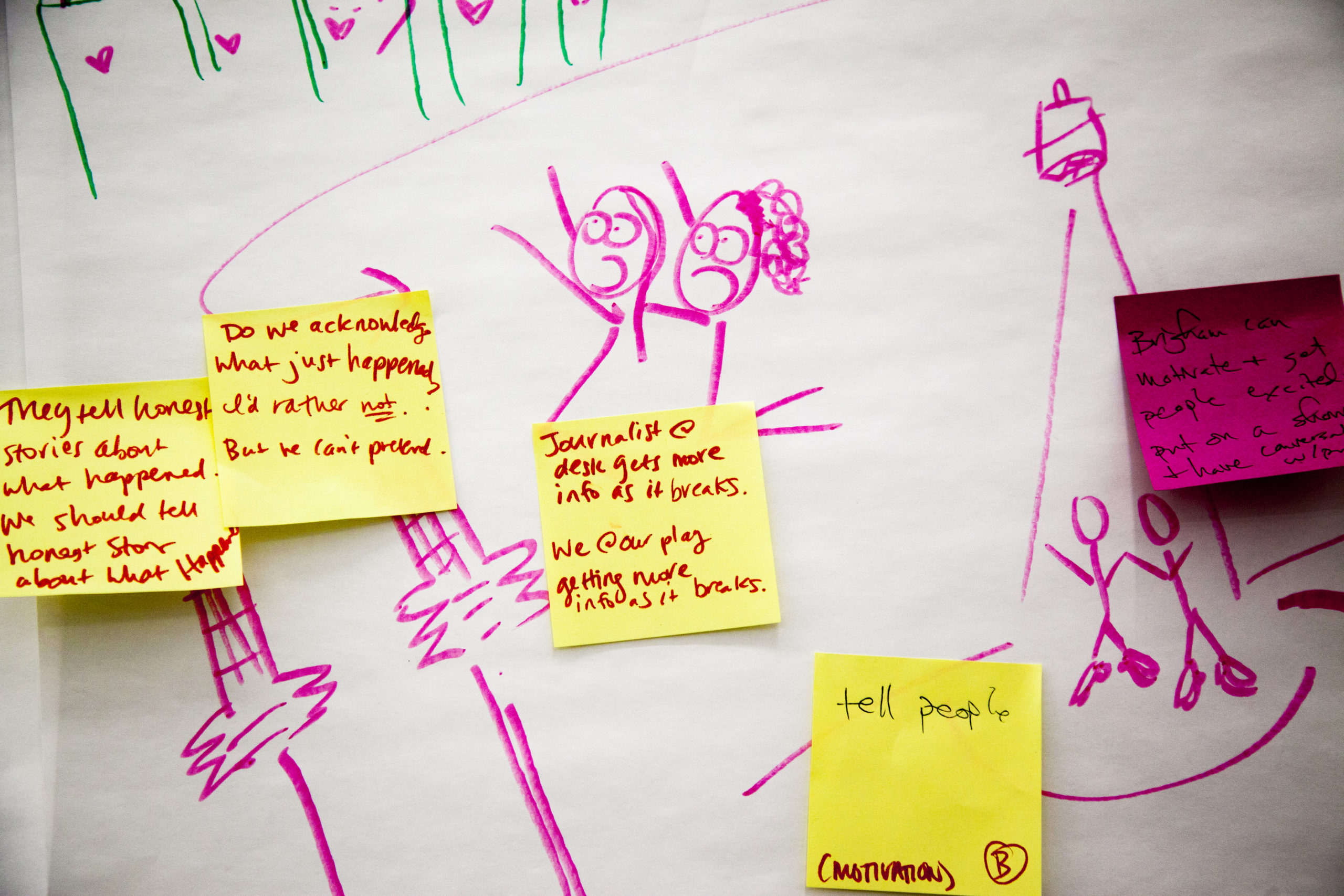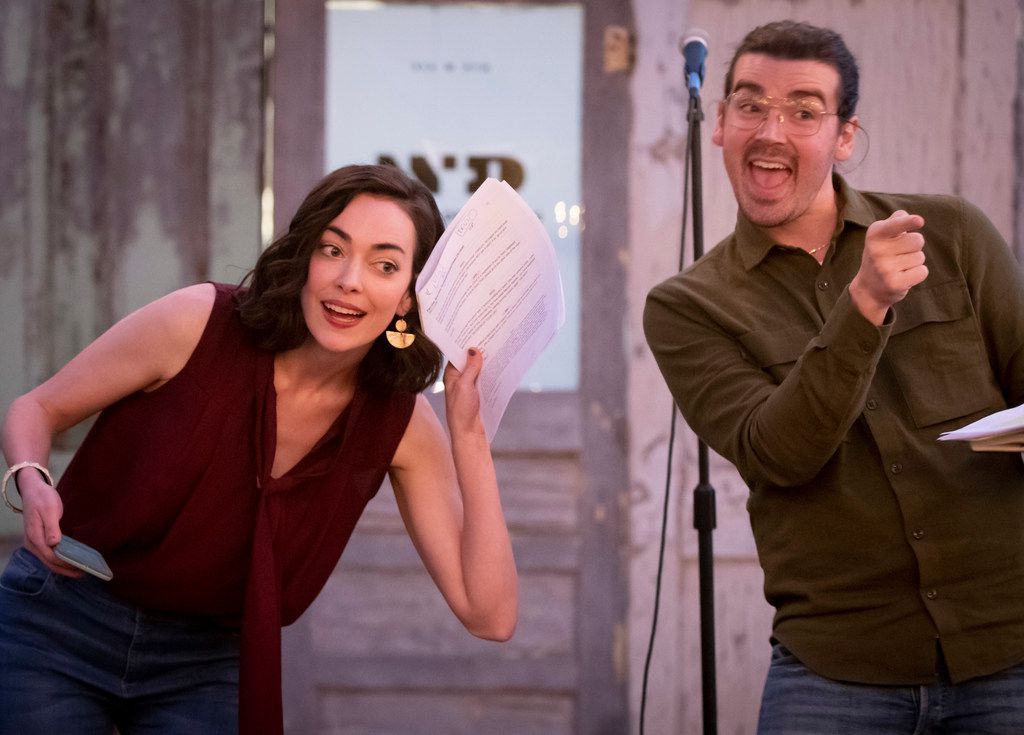For 10 days, two playwrights locked themselves into a room to create a play about local journalism. It would have five acts, two actors and tell the story of one local newsroom.
“And we came to a beautiful conclusion about how important journalism is and how it matters,” said Janielle Kastner.
There was just one thing missing – a big bad moment.
Kastner and Brigham Mosley knew that in act four, something would happen. But in those 10 days, they hadn’t quite figured it out.
The two finished their first draft in a play they created after embedding at The Dallas Morning News.
One month later, that newspaper cut 43 jobs, about half from the newsroom.
“And we had this moment of, well, that’s our big bad; what do we do?’” Kastner said.
They realized that for all they’d learned – what local journalism is, how it works, who performs it, why it matters – the story itself was a lot more complex.
Two and a half years after they started, more than a year after the layoffs, “Playwrights in the Newsroom” is ready for the stage. And the two playwrights who thought they’d be telling the story of one local newsroom discovered there’s actually a much bigger story to tell.
Related: At The Dallas Morning news, becoming truly digital means starting over

Sorry, we’re out of ticker tape
Kastner and Mosley first visited the Morning News in the fall of 2017. The building at 508 Young Street, known as “The Rock of Truth” for the inscription outside, was up for sale.
Inside, instead of ticker tape and shouting editors, the two found emptiness.
That space, home to the paper since 1949, was built for a bigger, print-focused newsroom. And The Dallas Morning News was, then, well into the process of working for digital audiences.
“There were empty rooms and empty desks,” Mosley said, “piles of newspapers, old file cabinets, sort of like a storage building.”
The playwrights went into the newsroom as part of a community engagement project first dreamt up with professor and art critic Lauren Smart and Tom Huang, the Morning News’ assistant managing editor for journalism initiatives and a Poynter adjunct faculty member.
How could the newsroom reach new, civically engaged audiences who weren’t readers?
What if poets came into the newsroom?
What about playwrights?
The concept comes from Joy Mayer, director of Trusting News, Huang said, and it goes like this: “To build trust and transparency with your community, you have to show trust yourself.”
That meant that the Morning News couldn’t dictate what did and did not make the play, and staff wouldn’t see the play until everyone else did.
The Morning News paid a stipend of about $250 each to the two playwrights. Their project also got financial support from local and national arts organizations – Ignite/Arts Dallas and PEN America – and was accepted into the 2019/2020 AT&T Performing Arts Center’s Elevator Project.
In the newsroom, Kastner and Mosley spoke with veterans and new journalists. They shadowed reporters covering beats including public safety and breaking news. They went to news meetings. They talked with the community at several events.
And they found that making and breaking news looked, well, kind of boring – a person sitting at a desk when that FOIA request comes through; someone navigating a spreadsheet to get at what’s really happening; a reporter listening and taking notes in a meeting.
“It was like, oh man,” Mosley said, “the movies are not right.”
They found, instead, something much more powerful. And complicated.

When no one’s looking
The playwrights met with several reporters, including city hall reporter Hayat Norimine. She told them about a meeting she’d covered where officials proposed cutting funding to several offices that provide social services. Then, Norimine wrote about it. A month later, the council reversed that decision.
“Several members of the public also urged the council throughout the process to focus on tackling poverty in Dallas and criticized the elected officials for considering cuts to proposed budgets for social service offices,” she wrote.
It was an up close look inside one of the quiet moments when decisions are made that impact people in her community, Kastner said, and the difference when a reporter is there to tell people what happened.
“I just didn’t realize it was that specific and that minute.”
The first half of Kastner and Mosley’s play explores the basics the two learned about news.
“It’s like a ‘Sesame Street’ sort of understanding of basic shapes and colors,” Mosley said.
It’s a neat, clean journey that leads to how the two felt after embedding at their local paper– informed, empowered, proud. It ends in a moment of lights and sound, Kastner said.
“And then that’s when the chorus announces that The Dallas Morning News has laid off 40-something folks.”
Act two might feel a lot like reality for many local journalists and people who care about local news – what happens next? Why do these jobs and why does this work matter? Who decides what’s true? Why don’t newsrooms look like the communities they cover? How does this become sustainable? How can people keep caring about everything that happens in their community?
When Kastner started the process of writing “Playwrights in the Newsroom,” she thought a lot about the privilege of fiction. She can create scenes that didn’t happen to show what did. She can convey a message without the 20-minute conversation it took to get there. But after the layoffs, as she and Mosley discovered the complications local newsrooms and communities face, that tension “felt more like a responsibility than a privilege,” she said.
And the whole process changed how both playwrights understand the news itself.
Related: This project takes investigative journalism onto the stage

Which Disney princess are you?
Before starting this project, Mosley got most of his news from BuzzFeed and Weekend Update on “Saturday Night Live.”
Kastner realized that when people talk about “the news,” they mean broadcast news. And while she reads national writers on things she cares about, “what local news is doing is different than that.”
Their process shows that smart, engaged people don’t know or understand what journalists do, the Morning News’ Huang said.
“We assume because we’re immersed in it that citizens know and value what we do, but it’s not true.”
Most people don’t know journalists or go into newsrooms. They think it’s this monolithic thing with an agenda, he said.
“They don’t realize it’s just real people who are trying to make the best decisions they can every day.”
When the two playwrights started spending time at their local newspaper, they asked some of the journalists there the same question – what happens if this fails?
The younger journalists figured they’d maybe write a book or move on to something else. But the veteran journalists had the same response.
“And the answer was always ‘democracy fails and corruption flourishes,’” Mosley said.
It seemed a little extreme the first time they heard it.
“We were babies then,” he said. “But the deeper you dig and the more you learn, that’s exactly what it is.”
“Playwrights in the Newsroom” runs March 5-15 at the AT&T Performing Arts Center in Dallas. Huang hopes that other local newsrooms will be inspired to invite the community in to help tell their stories.
And yes, the playwrights are now also Dallas Morning News subscribers.
Kastner subscribed in the first week.
She doesn’t read the news every day, but that’s not what she’s paying for, she said.
“I’m paying for a woman named Hayat to go sit in a room and make sure that if something happens to affect the actual bodies of people in my community, I will know about it.”
Mosley subscribed in the first month.
He was on a tight budget at the time, he said, and had to decide between subscribing to his local paper or staying with Weight Watchers.
“And I chose The Dallas Morning News.”

Kristen Hare covers the transformation of local news for Poynter.org and writes a weekly newsletter on the transformation of local news. Want to be part of the conversation? You can subscribe here. Kristen can be reached at khare@poynter.org or on Twitter at @kristenhare.







